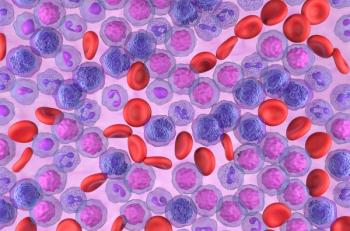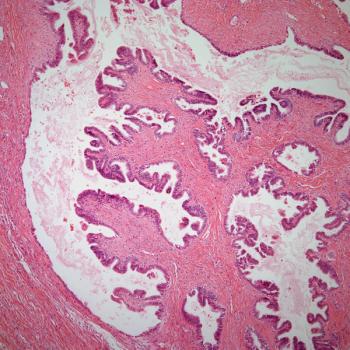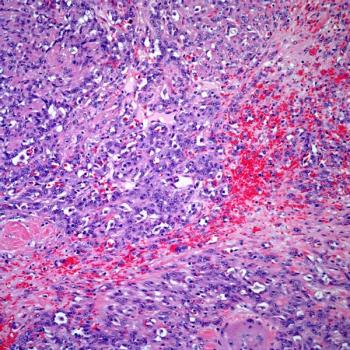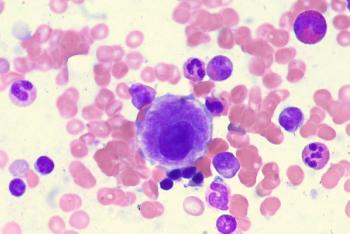
Over half of all patients with small cell neuroendocrine prostate cancer treated with BXCL701 and pembrolizumab were alive at 1 year in a phase 2 trial.

Your AI-Trained Oncology Knowledge Connection!


Over half of all patients with small cell neuroendocrine prostate cancer treated with BXCL701 and pembrolizumab were alive at 1 year in a phase 2 trial.

Elevated white blood cell counts also appear to correlate with shorter overall survival in patients receiving standard induction chemotherapy plus cytarabine for acute myeloid leukemia.

Investigators plan to share data from the phase 3 KEYNOTE-671 trial assessing perioperative pembrolizumab in resectable non–small cell lung cancer with international regulatory health authorities.

A biologic license application supplement resubmission for the pegfilgrastim-cbqv on-body injector follows the resolution of inspection findings highlighted in a complete response letter from the FDA.

Rates of obesity appear to correlate with increasing incidence of cancer in young populations, according to Monique Gary, DO, MSc, FACS.

Investigators of a phase 2 study suggest that relacorilant may add to a ‘sparse’ field of effective treatment options for patients with platinum-resistant or refractory ovarian cancer.

Investigators anticipate sharing final data from the phase 2 TELLOMAK trial assessing lacutamab among patients with cutaneous T-cell lymphoma in the fourth quarter of 2023.

Investigators report that MRI by itself seems to be an inadequate tool for determining pathologic complete response in rectal adenocarcinoma during total neoadjuvant therapy.

Investigators will continue to assess overall survival in patients treated with pembrolizumab for localized muscle-invasive urothelial carcinoma as part of the phase 3 AMBASSADOR trial.

While the majority of patients with breast cancer are women, men need to be considered when designing clinical trials.

Findings suggest that sensitive circulating tumor DNA analysis may be a valuable tool for guiding neoadjuvant treatment decision-making in early-stage triple-negative breast cancer.

Data from a study highlight that the breast cancer makes up the highest number of early-onset disease cases compared with other cancer types from 2010 to 2019, although overall cancer morality appears to have decreased.

Paolo Tarantino, MD, discusses how drug prices within the United States are affecting the treatment of breast cancer.

Patients receiving ibrutinib plus venetoclax for chronic lymphocytic leukemia appear to experience improved overall survival at 46 months compared with those receiving chlorambucil plus obinutuzumab in the phase 3 GLOW study.

Complete responses in patients with pretreated relapsed/refractory mantle cell lymphoma treated with glofitamab appear to be early and enduring.

In this September edition of Snap Recap, we share our highlights from Prostate Cancer Awareness Month, news in the breast cancer space, and the latest FDA updates.

Members of the committee reviewed findings from the phase 3 CodeBreaK200 trial, assessing the benefit of sotorasib in KRAS G12C–mutant non–small cell lung cancer.

Combining pembrolizumab with enfortumab vedotin-ejfv significantly improves responses vs chemotherapy among patients with previously untreated locally advanced or metastatic urothelial carcinoma.

Data from the phase 2 SGNTUC-019 study support HER2 as an actionable biomarker in patients with metastatic biliary tract cancer.

Findings from a meta-analysis support the feasibility of administering hysteroscopic surgery plus progesterone to patients of childbearing age with various types of endometrial cancer.

Investigators will present overall survival and objective response data from the phase 3 MARIPOSA-2 trial assessing amivantamab in EGFR exon 19 deletion–positive non–small cell lung cancer at a future scientific meeting.

Diagnostic CT-enabled radiation therapy also reduces patient-reported time burden in the palliative setting.

Two phase 2 studies are assessing the efficacy of BDC-1001 in several disease states, including colorectal, gastroesophageal, endometrial, and breast cancer.

Investigators are assessing AVB-001 as a treatment for those with high-grade serous adenocarcinoma of the ovary, primary peritoneum, or fallopian tube in a phase 1/2 trial.

Data from a phase 1 trial highlight a clinically acceptable safety profile for BI 764532 in patients with extensive-stage small cell lung cancer and extrapulmonary neuroendocrine carcinomas.

Patients with paroxysmal nocturnal hemoglobinuria can now self-administer pegcetacoplan subcutaneously following the FDA’s approval of an injector.

The marketing authorization application for imetelstat in lower-risk myelodysplastic syndrome is based on findings from the phase 3 IMerge trial.

Alisertib will be assessed in patients with small cell lung cancer as part of the phase 2 Study PUMA-ALI-4201.

Data from the FABREC trial support the use of hypofractionated postmastectomy radiotherapy in patients with breast cancer following implant-based reconstruction.

Data suggest a role for TIGIT blockade or CD25-positive cell depletion to enhance teclistamab’s efficacy in relapsed/refractory multiple myeloma.